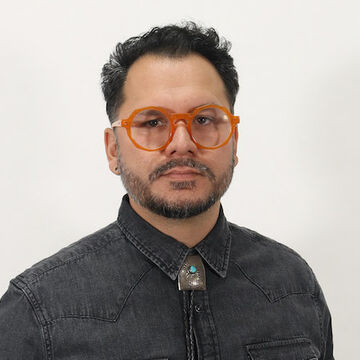

Salvador Jiménez-Flores
Associate Professor
Contact
Bio
Salvador Jiménez-Flores is an interdisciplinary artist born and raised in Jalisco, México. He explores the politics of identity and the state of double consciousness. Jiménez-Flores addresses issues of colonization, migration, “the other,” and futurism by producing a mixture of socially conscious installation, public, and studio-based art. His work spans from community-based work, drawing, ceramics, prints, and mixed media sculpture.
Jimenez-Flores is a member of The Color Network, an organization that promotes the advancement of people of color in the ceramic arts and assists artists develop, network, and create dialogue while maintaining a place for a database, resources, and mentorship. He is also a member of the Instituto Gráfico de Chicago, an organization inspired by the socio-political art of Mexico’s Taller de Gráfica Popular (The People’s Print Workshop) and uses art as a platform to inform and generate community discourse about urgent social issues.
Jiménez-Flores has presented his work at the National Museum of Mexican Art, Grand Rapids Art Museum, Urban Institute of Contemporary Art, Bemis Center for Contemporary Arts, Grounds For Sculpture and Museum of Art and Design amongst others. He served as Artist-In-Residence for the city of Boston, Harvard Ceramics Program, Office of the Arts at Harvard University, and Kohler Arts Industry. Jiménez-Flores is a recipient of Joan Mitchell Foundation Painters & Sculptors Grants and The New England Foundation for the Arts, Threewalls’ RaD Lab+Outside the Walls Fellowship Grant, and he is a 2021 United States Artist Fellow. He is an Assistant Professor in ceramics at the School of the Art Institute of Chicago.
Educational Statement
As an art educator I strive to create a comfortable and open classroom environment that encourages students to listen, share, respect, and learn from one another but more importantly a place where everyone feels they belong and are welcomed. Art making is one of the most satisfying and challenging careers and requires many hours of hard physical and mental work. Throughout my career as a designer, artist, educator and community arts advocate I have spent thousands of hours thinking, creating, questioning, listening, traveling, experimenting and particularly failing. I always tell my students that when one fails is a sing that one is pushing outside of one’s comfort zone. I prefer the phrase failing forward. I have never been afraid in making art and learning a new skill and so by losing this fear of failure I have been able to surpass my own high expectations. I encourage my students to learn from their life experiences and encourage them to take risks.
My goal as an art educator is to develop confident, socially-conscious artists and encourage them to find their voices and lose the fear in making art. Therefore, I create flexible art projects that encourage my students to explore topics of their own interest while also learning the technical skills they need to accomplish their work. Throughout my journey as an artist I have encountered many great teachers and mentors that have affected me immensely in a positive way. I have established long friendships with these inspiring individuals who have seen me grow as a citizen and as an artist. As an educator I want to impact the lives of my students in a positive way and inspire new generations of artists to then also continue guiding forthcoming generations—creating an unbroken chain of shared knowledge. Some of the common characteristics of the mentors and teachers that have influenced me are perseverance, passion, craftsmanship, and advocacy for social justice. These are the same characteristics that I want to pass on to my students.
As an educator I believe I have the responsibility to ensure that my students have the skills and the attitude to succeed in the very competitive contemporary art and craft field. I aim to implement as much professional practice within each of my classes so students feel comfortable doing research and crafting a visual and written proposal through their art projects. My experiences as an interdisciplinary artist provide me with the flexibility of working in a wide range of styles and media including drawing, sculpture, public art, video, installation and social practice to name a few. These diverse skill set helps me teach my classes more effectively and encourages interdisiplinarity in the classroom. My intention is to demonstrate the infinite possibilities in art. More importantly, awakening students’ curiosities and conflicts so they can learn how to develop their own content and ideas for their work.
As a teenage immigrant I have experienced the challenges of inequality at first hand. Migrating and adapting to a foreign culture, language, and life style were not easy but these experiences have made me the artist and educator I am today. I now enjoy the benefits of being versed with two languages and having access to music, literature, and gastronomy of diverse countries. My students benefit from my bicultural understandings and cultural sensitivity by creating an openness and awareness of our diversity. Consequently, my life experiences allow me to be more empathetic towards international students, first generations students, and underrepresented groups by creating a more inclusive and welcoming environment in the classroom and working effectively with a diverse student body.